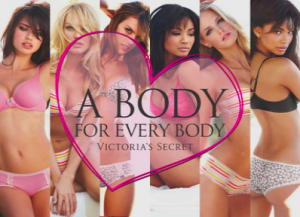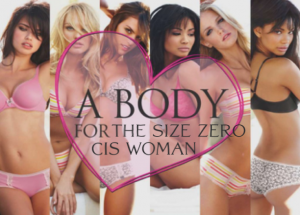
Original Advertisement
Victoria’s Secret’s fashion campaigns often play on the idea of the body. In this advertisement, “body” refers to the structure of their bras, as being suitable for every “body”, one’s physical body. Chief Marketing Director for Victoria’s Secret Ed Razek made comments in 2018 stating that Victoria’s Secret does not employ transgender or plus-sized models for campaigns because their inclusion in any of Victoria’s Secrets advertisement would “ruin a fantasy” (Munzenrieder, 2018). The fantasy that they are trying to promote is clear: by wearing Victoria’s Secret lingerie, you will look sexy and attract men. Put simply, he is implying that transgender and plus sized women are not appealing or sexy.
Ed Razek’s comments reinforce the ideology that is apparent in Victoria’s Secret’s advertising campaigns – that there is only one acceptable body type. This is depicted by the four white models and single mixed-race model shown twice who all share the same body type: thin. In addition, by only including one model of colour, viewers could internalize the subordination of the Black model and the perceived importance of showing a variety of White women. The standard of beauty Victoria’s Secret promotes is predominantly white, young, cis gender and size zero, perpetuating the unrealistic and exclusive expectations of beauty that are in constant promotion by the media.
This advertisement, “a body for every body”, is hypocritical in execution and ideology. What is interesting about this brand – one which claims to be in support of women’s expression and individuality – is that their head marketing director is male, and his words symbolize the heterosexual male gaze which influences female beauty standards globally. By overlaying the text “a body for every body” on images of skinny young women, the advertisement simultaneously includes and excludes a mass majority of women from the narrative who do not fit the size zero picture. Victoria’s Secret influences people to think that if they do not fit the picture they are less than or unworthy. These detrimental effects on women’s self-perception, led by a patriarchal male narrative of female beauty standards and regurgitated by mainstream brands with big platforms such as Victoria’s Secret, can lead to consequences such as eating disorders as people attempt to conform to how the ideal women is portrayed in mainstream media due to lack of representation (Bhandal, 2015).

Jammed Advertisement
In my “jammed” version of this Victoria’s Secret advertisement I emphasized the lack of inclusivity portrayed in an advertisement that originally explicitly proclaimed inclusivity through its text. By altering the text to say “A body for the size zero cis woman” I am highlighting Victoria’s Secrets unwillingness to promote anything but the form of ideal femininity established by the patriarchal male gaze – that is, the eroticized female body which is young, thin, and fit but still curvy in the right places. Their brand also believes, as mentioned earlier, that the ideal fantasy does not include transgender or plus sized women, which is represented in the jammed version through text, as well.
By representing only one form of femininity in their campaigns, Victoria’s Secret leaves women comparing themselves to a select few women who embody the ‘ideal woman’ characterized by the heterosexual white male – like Chief Marketing Director Ed Razek. Through Razek’s comments and obvious lack of representation of transgender women, Victoria’s Secret reinforces a gender normative ideology already prevalent in Western society (Jagose & Kulick, 2014). As a well-known brand with a huge platform, Victoria’s Secret’s absence of inclusivity represents the dominant norms in Western society which contribute to the injurious messages internalized by both men and women. By examining the intersections between gender, sexuality and age, illustrated in this advertisement through young, white, cis gender women, viewers can begin to pick apart the underlying message in this advertisement and others like it, understanding that the ideas are not okay and thus subverting the negative effects these advertisements.
Works Cited
Bhandal, Taq. (2015). Sex, Gender, Bodies and the Politics of Health [Video File]. Retrieved From https://canvas.ubc.ca/courses/27831
Butler, Judith. (1993) “Introduction.” in Bodies that matter: On the discursive limits of “sex”. New York: Routlege, pp. 1-23.
Jagose, Annamarie, & Kulick, Don. (2004). Thinking Sex/ Thinking Gender: Introduction. GLQ: A Journal of Lesbian and Gay Studies 10(2), pp. 211-212.
Munzenrieder, K. (2018, November 13). Victoria’s Secret Exec Explains Why They Don’t Use Trans or Plus-Size Models. Retrieved from https://www.wmagazine.com/story/victorias-secret-fashion-show-ed-razek-comments-trans-plus-size-models